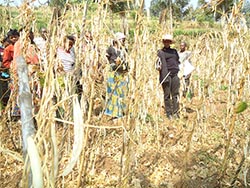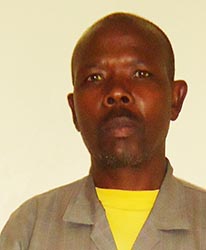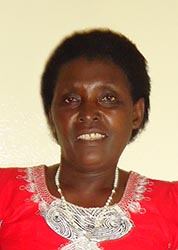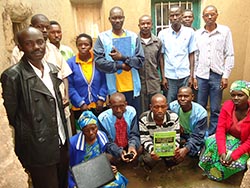Introduction
Rwanda was among the first countries where N2Africa activities started, early at the beginning of the project. Already in February 2010, the first hundred farmers were testing the soyabean technology called “need to inoculate”. Each farmer was hosting four plots, with two plots inoculated and two plots not inoculated. The results confirmed the need to inoculate soyabean. From then, N2Africa dissemination packages of soyabean included inoculants.
At the end of Phase I, more than 20,000 households from five districts of Rwanda had been reached with direct dissemination packages of legumes technologies, precisely soyabean and common bean.
Experience
The implementation of activities were based on partnerships with national and local partners at district level (considered as mandate area inside which action sites were selected). The strategy of disseminating technologies through individual packages of seeds, inoculants and mineral fertilizer given to each direct beneficiary under the supervision of a master farmer for ten to fifteen beneficiaries, gave good results in terms of reaching large numbers of farmers in a short period. At the same time, the demonstration plots, installed in parallel to dissemination packages, conveyed a message of awareness in the community.
Working through partners turned out to be challenging, because participating partners also had their own priorities. This sometimes created conflicting situations leading to delays in reporting. The need for a good strategy with accurate tools for M&E became inevitable. However, the good point working through partners is sustainability and continuity of interventions with less resources.
| Technologies tested and disseminated In Rwanda, technologies tested and disseminated included new varieties of soyabean, varieties of bush and climbing bean for biological nitrogen fixation (BNF), staking climbing bean using strings and the introduction of Purdue improved crop storage (PICS) bags for grain conservation (bean, maize and sorghum). Staking beans with strings in comparison with ordinary woods was promoted, as it showed several benefits: strings being more environmental friendly with less depletion of natural resources (wood), less expensive and higher grain yield. |
Picture 1. Participatory evaluation of technologies |
The PICS bag is a triple layer hermetic bag developed by Purdue University. The technology was originally developed for cowpea storage and tested in West and Central Africa. The bags are also effective for controlling pests of other grains. The advantage of PICS bags include:
No pesticide is needed to store the grain;
The grain can be stored for up to one year;
The bag can be reused for up to 4 years.
Under the N2Africa context of linking farmers to markets, a study was initiated to assess the efficacy of PICS bags in Rwanda. The pilot activities were conducted in three districts where pest infestations on grain in storage are usually high, due to favorable climatic conditions and hence reducing market opportunities for farmers, particularly for common bean and maize grain. A local manufacturer of the PICS bags was initiated using the sample bag brought by N2Africa. Today, the technology is spread in the country through local agro-dealers who also sell other agriculture inputs and tools. From this experience, Minagri started a program on post-harvest using the PICS bags. One Acre Fund also extended the promotion of PICS bags in other districts of the country.
Local capacity building and strengthening
Formal education: one PhD student (Mr Edouard Rurangwa) , two MSc students completed (Mr Alfred Tabaro Rumongi and Mr Domitille Mukankubana);
Short courses for technical staff of partnering institutions: two technicians from RAB trained in rhizobiology and local facilitators on BNF technologies;
Training of Trainers (lead farmers) who trained other farmers.
Success stories from partner farmers who worked with N2Africa since 2010
1. Seed production in Kayonza with Kundumurimo of Rukara sector
At the end of Phase I, a group of farmers, now a cooperative called Kundumurimo, started specializing in seed production for soyabean and bush bean. Nowadays, the cooperative sells seed at community level. The cooperative was trained by N2Africa to become a certified seed grower, registered by RAB. The seeds are produced on a piece of land of 40 ha in a swamp. This swamp provides irrigation possibilities and offers an opportunity to grow seed even off season. The cooperative produces certified soyabean seed and sells them to the Clinton Development Initiative.
1. Seed production in Kayonza with Kundumurimo of Rukara sector
At the end of Phase I, a group of farmers, now a cooperative called Kundumurimo, started specializing in seed production for soyabean and bush bean. Nowadays, the cooperative sells seed at community level. The cooperative was trained by N2Africa to become a certified seed grower, registered by RAB. The seeds are produced on a piece of land of 40 ha in a swamp. This swamp provides irrigation possibilities and offers an opportunity to grow seed even off season. The cooperative produces certified soyabean seed and sells them to the Clinton Development Initiative.
2. Soyabean processing business with Claudine in Bugesera
After a Training of Trainers organized in November 2011 for women from all action sites, Mukakayonde Claudine, from Mareba action site of Bugesera district, decided to start a business around soyabean processing. She started processing 250 grams of grain per day. Today she processes 2 kg daily, producing 12 liter of milk and the cake used for soya balls. Her daily net profit from the sales of milk and soya balls is 10,000 FRW (approximately $13).
3. High yielding climbing bean varieties changed the life of farmers in Musanze, Burera and Gakenke Districts
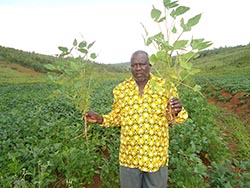 |
Picture 2, left: Seed production Kundumurimo District Picture 3, right: Staking climbing bean in Burera District |
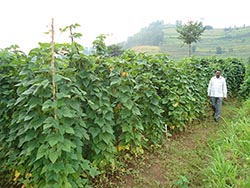 |
“In 2012, N2Africa gave me other bean varieties, which contain a high content of iron and zinc. Nowadays, I am capable to pay the medical insurance of my family and primary and secondary school fees for my five children. Recently, I also bought a plot of forest of 400,000 FRW from the sales of beans. I have become popular and referee for bean seeds in the district,” said Mr. Mbonigaba. “When I evaluate the past five years in which I have been working with N2Africa, I can see a lot of progress. In this region, bean is not only a food crop, but also a cash crop by excellence, because it is consumed on daily basis and has market. Besides increasing my bean production, I was also a lead farmer to assist other farmers. I was trained in legumes management practices, such as appropriate seed rates and investment and benefits calculations. I participated in several study tours organized by the project. This has built my self-confidence and I have gained consideration in the community and the district at large. I feel more considered in my society and I was selected to be contact farmer by local authorities to assist other farmers in my sector. I was trained by the Ministry of Agriculture and got a certificate. In November 2012, I was part of group of farmers who went on study tour to Western Kenya. From that visit, I gained a lot of knowledge in terms of how to join cooperatives and work with others to bulk the production for marketing. This helped me a lot as a lead farmer to assist farmers I was in charge of. On the way back, we managed to form a group, which is a member of a cooperative at the sector level. The cooperative plays a big role in advocacy and marketing of our production.” |
“Before working with N2Africa, I harvested 200 kg of beans in the same plot where I nowadays harvest 600 kg. The yield increased because of planting in row and applying organic manure with mineral fertilizer. The normal grain is sold at 300 FRW kg-1 and the improved variety is sold at 400 FRW kg-1 as grain. However, as a seed grower I sell it at 600 FRW kg-1. I gained knowledge on how to use improved inputs, growing for markets, and how to increase yield on a small plot. I also learned on how to process the harvest and add value through sorting and packaging the production. Since the land size is small and cannot change, I would like to invest in off farm activities, such as layer hens.” |
|
Mrs Nyiramanza Esperance, Musanze District, sector Rwaza, village Mutara “I started working with N2africa in February 2010. We started as a group of eleven farmers. Nowadays the groups consists of seven women. We started with an agronomic trial of climbing bean varieties. We harvested 96 kg of Gasilida bean. The following season we harvested 370 kg of Gasilida and RWV1348. We sold the harvested beans, and with some savings the group had, we bought two cows. Today, all seven women own a cow, from the two bought initially in 2012. In 2012, we started multiplying seeds for the three bio fortified varieties. After harvesting, we sold the produced beans. Each member of the group produced also at her own farm and contributed 2 kg for saving in the group. Now, the group has 300,000 FRW on their account.” “Through N2Africa, I learned and got knowledge on modern agriculture practices. I also learned how to manage my farm. I have developed myself, before I was an illiterate person, now I am more confident. The nutrition status of my family has improved, because I can buy other food stuffs such as oil, to prepare food. I pay school fees of my sons in private schools. In 2011, I planted 5 kg of Gasilida and harvested 180 kg, I sold 150 kg and gave 20 kg to the group, and kept 8 kg for seed for the following season. In 2012, I harvested 157 kg of Gasilida and 110 kg RWV1129, and sold the harvested beans and kept 8 kg.” “Before working with N2Africa, I used to harvest maximum 80 kg on those plots, using a local bean mixture. The production increased, because I plant in rows with the accurate seed rate and use new varieties, manure and fertilizer. My children could not attend high school if I had not joined N2Africa. My house had been looted by rebels, who destroyed it. Now I managed to repair my house and buy household items.” |
We grow beans twice a year. In September 2012, I multiplied 7 kg of RWV1129 and harvested 250 kg. I also harvested 200 kg of Gasilida, from 10 kg planted. The yield of RWV1129 was so good that farmers in the neighbourhood asked to get seed of that variety. I sold them at 700 FRW kg-1. In total, I sold 240 kg and kept 10 kg for my own seed. Now, I harvest 700 kg to 800 kg in season B, from 28 kg of seed.” “Before joining N2Africa, I used to plant like 80 kg of beans and harvested 300 kg. Now, I can see the difference in seed rate and yield. Through practical training in planting in rows, I reduced the seed rate. Furthermore, I use staking. I learned that also even men can weed the crop. Through the use of organic and mineral fertilizer, the yield has increased. Applying organic manure in planting rows instead of just broadcasting has also increased the yield.” “When I look back, I have improved my livelihood. I have improved my house roofing, cement, iron doors and windows, all from the sales of bean. It is easy for me to pay school fees for my kids without struggle. I have bought a pig in 2012 from the sales of beans. Today, I have four pigs and regularly sell young ones. My vision is to buy a milking cow, for milk and organic manure. I was trained on seed production technology by N2Africa, now I want to register and become a certified seed grower.” “I am very respected in my community, everybody sees me as a technician in agriculture. When I started planting in row, my neighbours were laughing at me. Now, they come to seek technical advice from me. I am a respected woman in the community. Others who learnt from me, have improved the yield. My husband shows more respect, since I don’t beg money from him, and contribute to the welfare of the family. The sector agronomist brings visitors to my farm to see a modern farmer. I really feel proud. Because of my modern way of growing beans in row, other projects also invited me to attend trainings and become a trainer for other farmers on other crops, such as Irish potato and tomato.” |
“I also received a package of soyabean, which I continued to grow and harvested on average 100 kg per year. This year, I harvested 80 kg. The package of bean was with cassava, and we harvested a lot. We sold fresh roots to a secondary school nearby. From the sales of cassava, bean and soyabean. Last year, we built a new house. From the sales of beans, we also grow vegetables, which also generate income to the household.” “As a lead farmer, I became popular in the area. I learnt to use mineral fertilizer, I cannot grow crops now without using mineral fertilizer. Every season average, I buy 100 kg of DAP and urea.” |
|
Mr Ntungiyehe Xavier, Kamonyi District, sector Musambira, village Gihembe “I started working with N2Africa in 2011B season when I received a dissemination package of soyabean, maize and fertilizer. I planted and was given instruction on how to use the package of 300 grams of soyabean (SB24). I harvested 15 kg of soyabean. COCOF bought 10 kg to disseminate to other farmers. I kept 5 kg, which I planted again, during that season I was also trained as a lead farmer to help other farmers. I assisted 8 farmers. The following season, I assisted 20 new farmers beneficiaries of the project. From the 5 kg planted, I harvested 260 kg and sold the production at 450 FRW kg-1 to COCOF and other farmers as seed. Farmers liked the variety so much, they always asked for seed. Last year, I planted Squire, which is more productive than SB24. I harvested 380 kg, I sold and saved 150,000 FRW on my account at SACCO. This year, I bought a plot for farming 35m x 28m. This year, I harvested 150 kg, sold 100 kg at 600 FRW kg-1 and kept 50 kg for home consumption and seed. We consume soyabean at home roasted for sauce and porridge.” “Before joining N2Africa, I did not grow soyabean. However, I saw how much money I could earn from the soyabean production. So I reduced the area planted in bean to be replaced by soyabean. Soyabean has a better yield compared to bean. I argued with my wife to replace bean by soyabean and at the end I convinced her. And we moved from bean to soyabean, as a cash crop.” |
|
Mr Habyarimana Leonce, Kamonyi District, sector Musambira, village Bitsibo “I started working with N2Africa at the beginning in 2011. We received a training of lead farmers. The training helped me to improve the soyabean production, planting in rows using inoculants and other inputs and harvesting plants without pulling. Before N2africa, I used to harvest 40 kg per season. After the training, I applied the knowledge acquired and I started to harvest 200 kg to 300 kg per season. I have 20 ares. The average yield of that plot is about 300 kg. I sell the production at 500 FRW kg-1 to RAB as a seed grower. After selling I save my money in SACCO, EJO HEZA. From SACCO, I got a loan and built a commercial house in center of Nkomane. I got a credit of Mobisol and started a business as hairdresser. The loan was 250,000 FRW. COCOF gave me a guarantee, because I worked with them. I got a credit of Mobisol of 1 million FRW. I also rent land to grow more crops. From the Mobisol loan, I pay 27,000 FRW month-1, which I get from the sales of my agriculture production. |
Beyond N2Africa
The following stories narrate two cases where farmers who worked with N2Africa got ideas on how to ensure continuity of interventions.
|
Picture 8. Legume platform members Kamonyi District |
There are three more One Stop Shops run by other cooperatives in the former N2Africa action sites. In these shops, farmers can get technical messages and buy legume seeds, other inputs and fertilizers.
To conclude
N2Africa in Rwanda was very successful with BNF technologies increasing legume productivity and the level of technology adoption was strong. There are a number of local initiatives who took over from the formal technology dissemination process and contribute to ensure continuity of N2Africa interventions in Rwanda.
Kantengwa Speciose, Country Coordinator Rwanda

